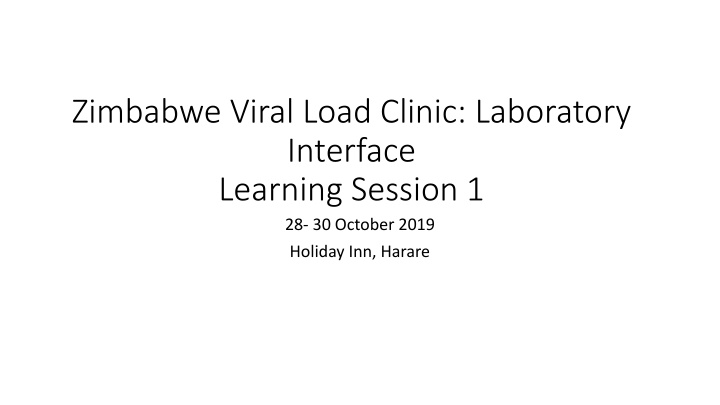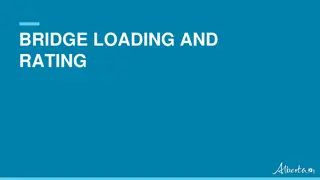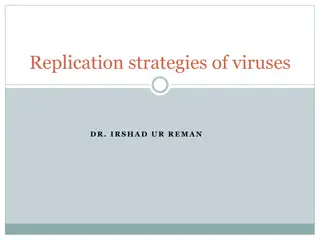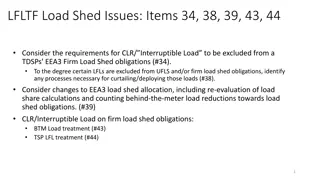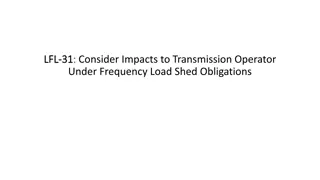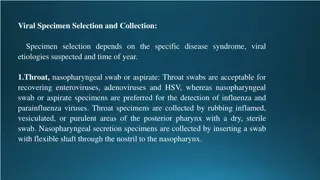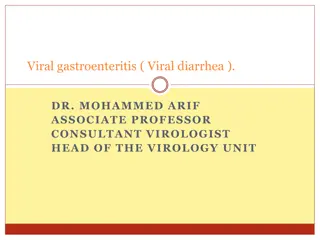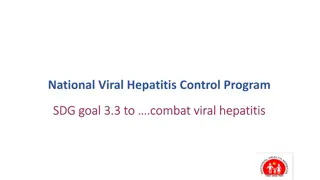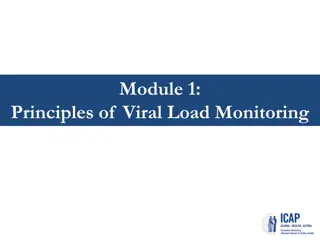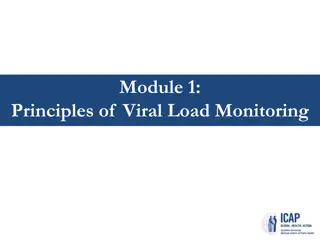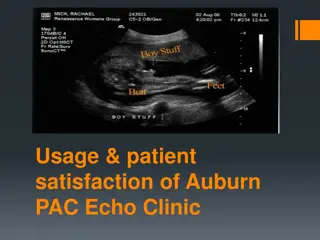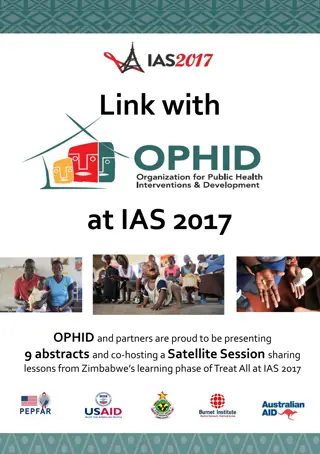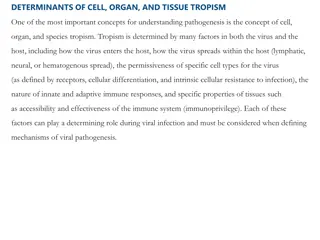Zimbabwe Viral Load Clinic: Laboratory Interface Learning Session and Country Context Update
Zimbabwe hosted a vital learning session on viral load clinic laboratory interfaces and the epidemiology of HIV in the country. The session aimed to sensitize participants on the VL CLI, introduce the LARC team, and identify gaps in managing clients on ART with high viral loads. The country context reveals Zimbabwe's significant burden of HIV/AIDS and TB, showcasing progress and challenges in HIV services decentralization and partnerships with major organizations.
Download Presentation

Please find below an Image/Link to download the presentation.
The content on the website is provided AS IS for your information and personal use only. It may not be sold, licensed, or shared on other websites without obtaining consent from the author.If you encounter any issues during the download, it is possible that the publisher has removed the file from their server.
You are allowed to download the files provided on this website for personal or commercial use, subject to the condition that they are used lawfully. All files are the property of their respective owners.
The content on the website is provided AS IS for your information and personal use only. It may not be sold, licensed, or shared on other websites without obtaining consent from the author.
E N D
Presentation Transcript
Zimbabwe Viral Load Clinic: Laboratory Interface Learning Session 1 28- 30 October 2019 Holiday Inn, Harare
Outline Objectives and Outputs of Meeting Epidemiology of HIV in Zimbabwe Evolution of ART Provision in Zimbabwe(2004- 2019) Viral load background in Zimbabwe Progress Made and Challenges in viral Load Services Link with VL CLI
Objectives of Learning Session Sensitize participants on the VL CLI To introduce the LARC team Prime participants on the QI principles Identify current gaps in management of clients on ART with high VL Develop plans for the first Action Period
Expected Outputs Engaged stakeholders with QI capacity Facility plans for Action Period 1 of the VL CLI
Country Context: Zimbabwe remain one of the countries in the world heavily burdened by HIV/AIDS & TB 1.3m PLHIV 1,25m adults 76,592 children (2017 HIV estimates) HIV Prevalence: 13.7% among 15-49 yr age group Female 16.7% Male 10.5% HIV Incidence: 0.48% in 2016 (down from 1.42% in 2011, 0.98% in 2013) Total Popn ~ 13 million (2012 Census) (ZIMPHIA, 2016) MTCT rate 6.7% (2017 HIV estimates) TB/HIV co-infectivity rate of 63% [Global TB Report, 2018]
HIV services have significantly been decentralised since program inception which has brought services closer to those who need them . Health facilities offering HIV Services as @ June 2019 2,000 100% 90% 83% 1,800 86% 86% 1,600 1,400 79% 1,200 59% 1,000 1,874 1,688 1,614 1,614 800 1,560 39% 1,280 600 1,099 400 624 200 0 Number of health facilities Number of HTC sites Number of PMTCT (Option B+) sites Number of ART sites Number of PEADS ART Number of VOLUNTARY MEDICAL MALE CIRCUMCISION sites Number of IPT sites EPMS sites sites Facilities Proportion of sites offering services Major Partnerships: NAC, PEPFAR( USAID, CDC), GF, DFID, JSI , WHO, UNICEF, UNAIDS, MSF, CHAI Source-DHIS2
Addendum to the 2016 National ART Guidelines Evolution of the OI/ART Programme, 2004 - 2018 2016 National ART Guidelines 2013 National ART Guidelines 1,200,000 1,150,079 1,119,909 2010 1,000,000 Number of patients National ART Guidelines 975,667 879,271 800,000 787,980 600,000 665,199 565,675 486,675 400,000 362,817 139,251 235,440 11,000 25,867 53,632 41,905 200,000 0 Country introduced OI/ART programme in April 2004 guided by Nationwide Scale-up of ART plans covering periods 2005-2007; 2008 2012 & 2013 2017, Prior to 2016 Guidelines, targeted VL testing for suspected treatment failure, and then routine VL for all clients on ART since 2016
Viral Load Testing Coverage, 2015 - 2018 1,800,000 50% 45% 45% 1,600,000 40% 521,713 1,400,000 VL Testing Coverage (%) 333,656 35% 1,200,000 30% 111,042 Number 1,000,000 30% 53,569 25% 800,000 20% 975,667 600,000 1,150,079 1,119,909 15% 11% 879,271 400,000 10% 6% 200,000 5% 0 0% 2015 2016 2017 2018 ART VL Tests Achievement(%)
Despite routine VL having been scaled up significantly since 2016, VL testing coverage remains low Low viral load capacity utilization . From Jan-Jun 2019, a total of 143,040 (31% of the target) VL tests were done and VL suppression was 87% Country has adequate VL testing platforms deployed country wide [both conventional (22) & POC (100)] however, with limited capacity utilization Challenges relating to VL testing include: Sample transportation system Extended total Turnaround Time 1200000 1000000 800000 Numbers 600000 400000 200000 0 2014 2015 2016 2017* Jan - Sept 2017 # ofVL test PLHIV on Txt VL capacity Source: 2017 ART End Term Programme Review
Progress towards targets Adults Estimated 90-90-90 Estimated Progress Children Estimated 90-90-90 Estimated Progress 100 100 91 89 89 87 84 81 81 78 77 77 77 80 80 74 72 70 70 68 66 61 61 61 61 57 57 60 60 54 52 52 52 46 % % 42 42 40 40 40 40 40 33 33 30 26 26 20 20 0 0 0 0 0 0 0 0 0 0 2010 2011 2012 2013 2014 2015 2016 2017 2018 2010 2011 2012 2013 2014 2015 2016 2017 2018 Know their status (%) Have received ART (%) Have suppressed viral load (%) Know their status (%) Have received ART (%) Have suppressed viral load (%) Source: Draft Shiny 90, 2018 HIV Estimates
Proportion of active patients enrolled in ART from 2013-2017 with suppressed VL from the first VL test stratified by age at health facilities with ePMS and in ART care for at least 12 months from ART initiation (N=114,857) 100 Adolescents aged 10-19 years had the least proportion of active patients that were suppressed (58%) compared to all the other age groups. 87.7 90 84.5 81.7 80 75.4 VL Suppression rate (%) 70 60.9 58 60 50 40 Older age groups tended to have higher proportions of active patients on ART that were virally suppressed 30 20 10 0 <10 yrs 10-19 yrs 20-29 yrs 30-39 yrs 40-49 yrs 55+ yrs Source: ePMS 2018
What does our gap to VL coverage look like? Coverage Vs Testing Gap All-Age, Sex
Suppression Suppression All-Age, Sex Adult Male Suppression Suppression Adult Female Pediatrics
2018 Viral Suppression by Province 89% 88% 88% 87% 87% 86% 86% 86% 85% 85% 85% 85% 85% 84% 84% 84% 84% 83% 83% 82% 81% 80% Bulawayo Harare Manicaland Mashonaland Central Mashonaland East Mashonaland West Masvingo Matabeleland North Matabeleland South Midlands (blank) Overall
Management of PLHIV enrolled in ART care with High Viral Load in the Zimbabwe ART Program, 2004-2017 Leakages along the VL care cascade 840,971 patients entered in the ePMS 721,514 (85.8%) never had a VL done 119,457 (14.2%) ever had a VL done 85.8% 96,754 (81%) have VL<1,000 22,703 (19%) have VL 1,000 65.8% 7,764 (34.2%) had a follow-up VL done 4,688 (60.4%) had 2nd VL 1,000 3,076 (39.6%) had 2nd VL<1,000 57.5% 1,991 (42.5%) switched to 2nd-line ART Source: ePMS Report, 2018 Missed opportunities in actioning on unsuppressed VL result reaching the 3rd 90 Unavailability of resistance testing with most clients accessing service from private sector (US$200 US$700/test Limited 3rd line options due to unavailability of single formulations of NRTIs
Viral Load scale up in Zimbabwe: Clinical challenges Weak Sample transportation Long TAT and inadequate systems to track TAT No system for facilities to track coverage of routine VL monitoring of client cohorts Shortages of critical M&E tools for VL monitoring of VL for clients, leading to a improvisation For facilities with tools, inadequate documentation of VL sample collection and results leading to data quality issues. For clients with high VL load- inadequate documentation of EAC sessions, repeat VL, recording of repeat VL Result, and whether clients re-suppressed or switched to second line
Link with VL CLI With the current challenges, MOHCC will be implementing a VL CLI over the following phases to address them, Phase 1: Increase VL results recorded in green booklets from baseline to 95% by November 2020 Phase 2: Increase proportion of clients with a high initial VL managed according to guidelines from baseline to 90% by November 2020 Phase 3: Increasing 12month VL coverage in participating facilities from baseline to 90% by November 2020
Mbare Polyclinic Kuwadzana Polyclinic Parirenyatwa Central Hospital Zengeza Polyclinic Seke North Clinic Hatcliffe Polyclinic Beatrice Road Infectious Disease Hospital Laboratory National Microbiology Reference Laboratory St Marys Clinic Chitungwiza Central Hospital Hopely Clinic Overspill Clinic Epworth Polyclinic Budiriro Polyclinic PSI Laboratory- Chitungwiza
